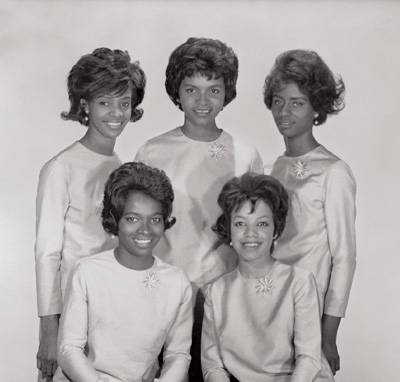Unlike Mary Wells (“every teenage boys understanding sweetheart”) or the Supremes (“untouchable, preening dream goddesses”), the Velvelettes were, as Detroit author Susan Whithall writes in Women of Motown, “the archetypical early ‘60s college girls: wholesome, likeable and cute,” and while they deserved more and bigger hits, their best recordings were as smart as they were, sly girl-group confections straight out of Hitsville.
FAST FACTS:
- First Hit: “There He Goes”
- Biggest Hit: “Needle In A Haystack”
- Biggest Album: Very Best Of The Velvelettes
- Career Highlight: The release of “He Was Really Sayin’ Somethin’” not only gave the Velvelettes their second consecutive hit, it was the the group’s own favorite and became a Motown classic, later frequently covered — most notably by Bananarama, going Top 5 in the UK and heavily played on the fast-rising MTV television network.
Forming at Western Michigan University in Kalamazoo, the Velvellettes come together in 1961 at the school around two cousins (Bertha and Norma Barbee), two sisters (Mildred and Carolyn “Cal” Gil ), and a friend (Betty Kelly) for a fraternity talent contest. Only Bertha and Mildred are students at Western; Norma attends Flint Junior College and Cal is a ninth grader in Flint — they travel to Kalamazoo regularly to polish the act – while Betty is an 11th-grader in Kalamazoo. Despite being the youngest, 14-year-old Cal’s confident, expressive voice, makes her a natural lead singer. The five initially call themselves Les Jolies Femmes (French for The Pretty Women) and they win the contest and its $25 prize.
They five continue singing together and their harmonies cause friends to say they sound “smooth as velvet.” They change their name to The Velvelettes.
Among their admirers at Western is fellow student Robert Bullock, a nephew of Berry Gordy. He arranges an audition for the group at Hitsville in Detroit. Arriving from Kalamazoo on a snowy Saturday, they are told no auditions take place on weekends and, crushed, are about to leave when Motown’s A&R Director Mickey Stevenson enters the lobby. The Barbee cousins recall him from singing on a record he produced a few years earlier and Bertha persuades him to hear them sing. Stevenson would later write in his autobiography, “I signed them up quick, fast and in a hurry.”
With Stevenson producing, the Velvelettes begin recording in February, 1963 and a month later, they cut “There He Goes,” which becomes their first single in July, backed with “That’s The Reason Why,” both featuring Little Stevie Wonder’s wailing harmonica. Gordy passes on it so Stevenson releases it on his own IPG label. It becomes a regional hit in the Midwest and the group tours to support it, largely on weekends so it does not interfere with school.
In February ’64, Motown stages a “Battle Of The Stars” competition among its acts at Detroit’s Greystone Ballroom and the Velvelettes draw the Supremes as their “foes” in a five-songs-each faceoff. The crowd response favors the energetic Kalamazoo girls over Diane, Mary and Flo, who are still a few months away from releasing “Where Did Our Love Go,” their first Number 1 hit.
Eventually, the Velvelettes relocate to Detroit but later in 1964, Betty leaves the group – with the other Velvelettes blessing – to join Martha and the Vandellas. When the Velvelettes enter the studio shortly after to record Stevenson and Norman Whitfield’s tune, “Needle In A Haystack” in July ’64, Mildred is also absent on maternity leave, reducing them to a trio. Producer Whitfield asks the group to come up with their own background vocals — which they do, borrowing the “doo-lang” phrase from the Chiffons’ “He’s So Fine.” Released on the V.I.P label in September, it becomes their national breakthrough, peaking at Number 45 on the Pop chart, making it Motown’s first V.I.P. hit.
Mildred rejoins their follow-up session in early December, an ingenious Whitfield-Stevenson-Eddie Holland composition matched by a robust Funk Brothers track and Cal’s feisty lead on “He Was Really Saying Something.” Whitfield again lets the girls create their background vocals, and they deliver the immortal ‘Do-wahda-wahda” and “Bob-bop-suki-do-wahdah.” It is their final single recorded with only original members and although it charts both pop (64) and R&B (21), it deserves a far better legacy.
The success of “Sayin’ Somethin’” increases tour dates and TV appearances, but by mid-’65, Norma leaves the group for her young family and education while Bertha and Mildred also begin phasing out. Cal recruits Annette McMillan and Sandra Tilley to replace them, but Bertha and Mildred continue recording, joining the newcomers to back Cal on “Lonely Lonely Girl Am I” in the spring of ’65. While it fails to chart, it remains a favorite of both the group and their fans.
The same background foursome accompanies Cal in the studio a few months later for “A Bird In The Hand (Is Worth Two In The Bush),” another Whitfield production featuring another strong Funk Brothers track. After this record also fails to chart, Bertha and Mildred depart the group.
Motown shifts the Velvelettes’ production duties to Harvey Fuqua and Johnny Bristol and move them from the V.I.P. label to Soul. Recorded in April ’66 and released in August ’66, “These Things Will Keep Me Loving You” reaches 43 on the R&B chart and just misses the Top 100 pop chart. Coming at a time when hit singles from Motown’s top tier artists dominate the charts, the undeniable quality of “These Things…” allows it to also squeeze onto radio playlists. But it is the final single Motown releases on the Velvelettes.
The trio continues to record through 1967 and tour for a couple of years longer, but Motown declines to release any new material and a planned album never happens. Promising songs like 1965’s “Let Love Live (A Little Longer)” and 1967’s “I’m So Glad It’s Twilight Time,” remain in the vault for over two decades.
In 1969 Sandra Tilley joins Martha & the Vandellas and Cal marries Richard Street of the Monitors (and eventually the Temptations). Focusing on her marriage and and enroling in college, Cal decides to dissolve the Velvelettes.
In 1971, as the Motown Sound seizes the imagination of British audiences as never before, “These Things…” is reissued by Tamla-Motown and climbs to Number 34 on the UK chart. Cal is unaware of the hit until Richard returns home from a Temptations European tour and informs her.
Although they had become college grads, mothers and career women, the Barbee cousins and Gill sisters suddenly find themselves back on stage again after 14 years when Bertha reunites them to provide entertainment at a women’s conference in Kalamazoo. “The old feelings started coming back,” Bertha would tell Susan Whithall years later, and the performance is so well received that the Velvelettes are reborn in 1984 and remain together thereafter, largely working on weekends – the only Motown group from the classic years still performing with its original members.
In 1990, as part of Producer Ian Levine’s massive Motor City Records project, he records an album with the Velvelettes, their first, on which they update their biggest hits and tackle Levine’s original material.
In 1999, Motown finally releases a Velvelettes album, The Very Best Of The Velvelettes, a CD compilation of their singles with four previously unreleased tracks. The group themselves contribute the booklet’s essay.
In 2001, Universal Music in the UK releases a CD compilation The Best Of The Velvelettes, containing four additional previously unreleased tracks. Again, the Velvelettes tell their story in the booklet’s essay.
In 2004, a goldmine of Velvelettes recordings finds release on a 2-CD set The Velvelettes: The Motown Anthology from Universal in the UK. It contains 48 tracks, over half previously unreleased songs, mixes or alternate versions of their studio work, plus the group’s 1964 Greystone Ballroom live performance and four French language recordings. Once again, the CD booklet’s essay comes from Velvelettes themselves.





